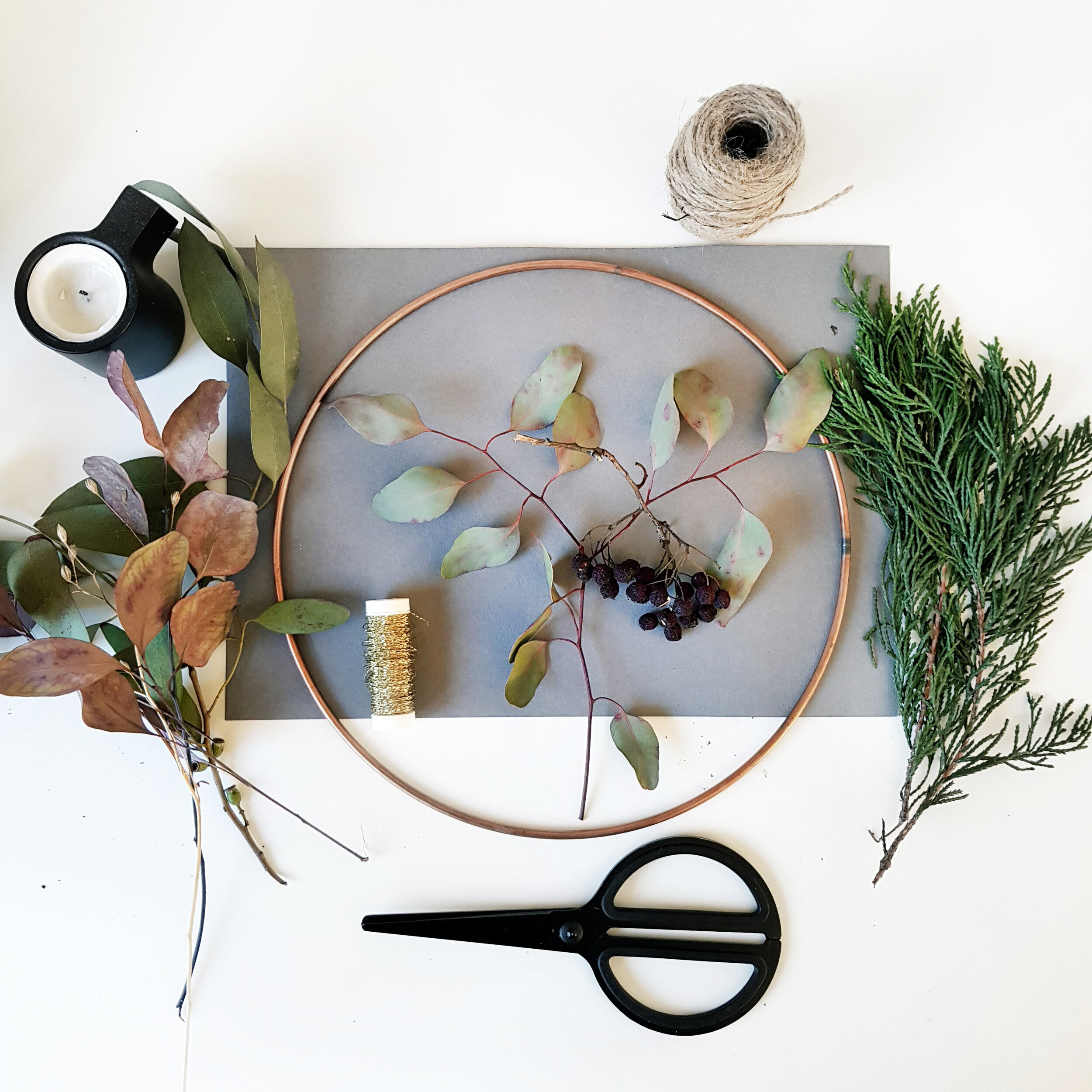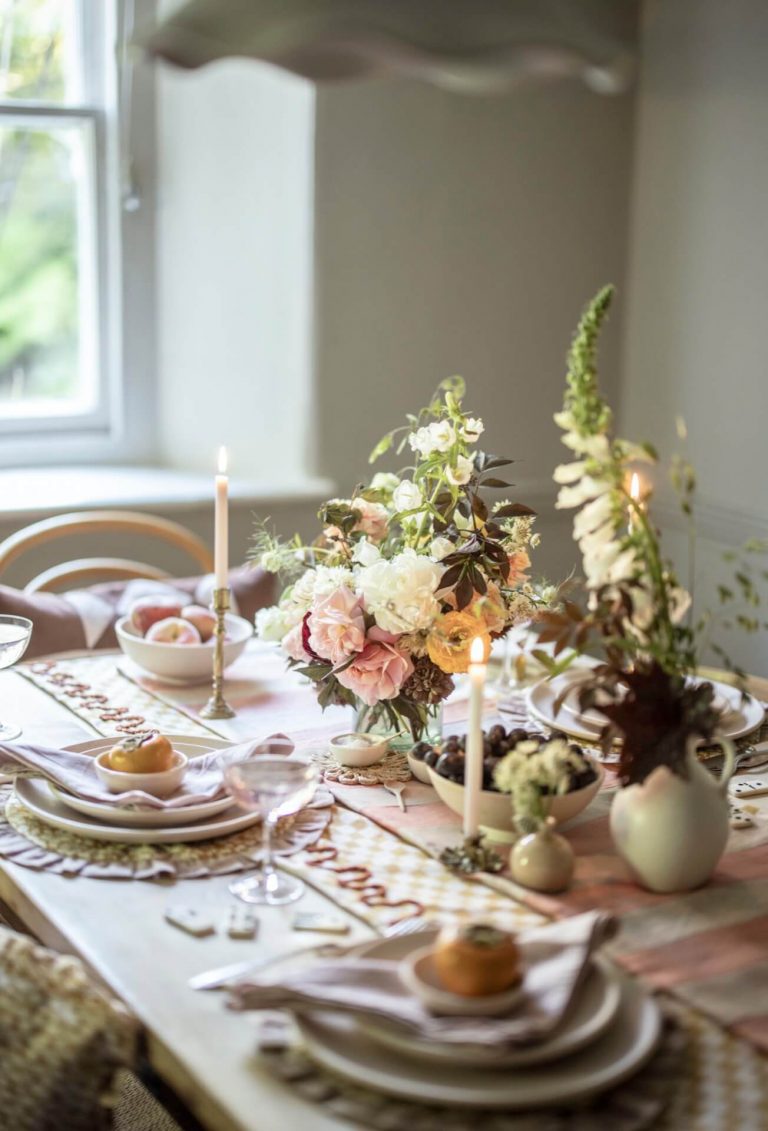Are you embracing winter and the approaching festive period? Wrapping yourself warm in scarves and hats, sipping hot chocolate and singing along to those memorable tunes from Christmases past? Decorating our homes is such a joyous way to bring festivity to the darkest time of year, and we particularly love creating decorations by hand with natural elements, wreaths being one of our favourite things to get crafty with. Aiste Bolton firstly looks into the history of these nostalgic objects before showing us how to make our own minimal winter wreath.

Where did the tradition of hanging wreaths come from?
The exact origins are still debatable to this day, however, displaying wreaths has always implied some kind of celebration. The tradition of hanging them on doors can be traced back to Ancient Rome, where it symbolised a victory after winning a battle. Following the symbolic meaning, it‘s believed that wreaths worn as a headband in the Persian Empire and Ancient Egypt, were a sign of power and authority. In Ancient Greece, harvest wreaths were used as a sacred amulet and displayed by the door all year round. Young lovers used to hang wreaths on each others’ doors too as a sign of affection. In Christianity, the wreath also holds a significant meaning – its circular shape represents eternity, as it has no beginning and no end; a never-ending circle of life.
The Christmas wreath, as we know it today, is mostly associated with Christian tradition, to hang it on the door or in the window to invite Christ into our homes. However, it is also connected with the ancient Scandinavian’s pagan feast of Yule (and comes from the Nordic word, meaning wheel, as a wheel of life), a celebration of the winter solstice, the end of the longest night and return of the sun.
Wreaths were traditionally made from evergreens, including holly, ivy, pine and yew, each of them having their own symbolic meaning. For example, evergreens represent eternal life and strength, as they can withstand the harshest weather conditions and live through all the seasons.

Bringing nature indoors
Decorating our home with a handmade wreath is a gesture of gratitude we pay back to nature when it has the least to offer. This is a sacred time of the year, when through its bareness we reconnect with ourselves, finding our cosy shelter at home. Embracing the stillness which often gets lost in our busy lives. Accepting the cold, knowing that the darkness will pass. Bringing greenery in is a good reminder, that there’s still life to be appreciated, even in winter. Do not miss what lies in front of you. Look out for fallen branches or twigs, forage whatever beauty you find when out walking; stay in tune with nature.
While you would always make a local florist happy by purchasing a ready-made Christmas wreath, I invite you to make one yourself, even if you’ve never tried it before. Creating your own wreath can be a rather enlightening experience. Its beauty lies not in any particular technique or materials you use. It‘s all about the feeling; slowing down for a minute, making yourself a nice cup of tea, maybe lighting a candle or two, turning on some calm music or just staying in silence and diving into the magic of Christmas crafting. Remember, there’s no need for perfection. You can’t go wrong either. Taking as much or as little time, it’s all about the enjoyment of the process.
How to make your own Christmas wreath
While there are so many beautiful designs to choose from, start simple. Don’t get yourself wreathed out at the beginning. A minimalistic indoor wreath is easy to make and looks super stylish.
Choose your favourite greenery and consider adding some dried flowers too. Knowing how and where you’re going to display your wreath might help you decide on foliage. Long stems would always fill the space nicely – such a wreath would act as a statement piece on a wall. While one with shorter stems has a more subtle approach and can look good when a few are grouped together.
Think texture and colour. A Christmas wreath doesn’t have to be a conventional one. Mix different shades of green, brown, purple and yellow, whatever you come up with. You’re a big fan of pampas grass? Add a few in! Feathers, dried berries? Yes and yes. It’s your wreath, your rules. But to get you started, here is a simple design to follow, which you can add to or amend as you wish…

You will need:
- a 10” copper ring (although you can pick any size or colour you want. A wooden embroidery hoop would do the job too)
- Gold craft wire (alternatively you can use green florist wire)
- Scissors
- A piece of fabric (choose natural materials: silk, cotton, linen)
- Conifer twigs
- Mixed eucalyptus (you can use fresh or dried, though the fresh stem is easier to work with)
- Dried berries

Method:
Start from the left side, laying the conifer twigs facing upwards, covering about 2/3 of the ring. (You could use pine branches here, however, conifers have a finer yet denser structure and serve as a more delicate base, and tend to take longer to dry out.)
Cut small pieces of wire and attach the conifers to the ring by twisting the wire at a few places so that the twigs stay bent.

Continue by adding the eucalyptus stems (I cut them to approximate size of 12’’/30 cm): place on top of conifers and using metal wire secure them to the ring. Work from the top left down to the right. Add a few layers and mix up the varieties of eucalyptus if you have them. They also dry out beautifully, not to mention their lovely smell.

Finally, use ribbon or strips of fabric to hide the stem ends or just add more foliage facing the opposite way, as I did.
Voila! You could hang your wreath either by placing the ring straight on a hook or hanging with some twine.
Project & photos: Aiste Bolton










